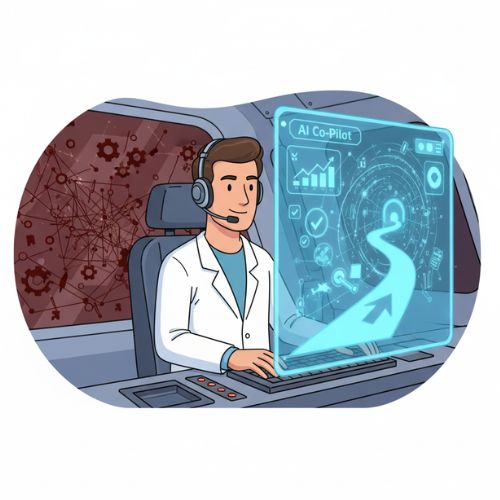Modern Medical Device Document Change Management
Have you ever wondered how complex products—from software to smartphones—are improved and updated over time? We often see the final result, but the process of managing change is a discipline in itself. In most industries, a flawed change process might lead to budget overruns or a delayed launch. But in the world of medical devices, the stakes are infinitely higher.
In this industry, change isn't just about innovation; it's a deeply disciplined process where every decision can impact patient lives. The methodical way medical device companies handle modifications to their products and processes offers powerful lessons for any organization. This post reveals four surprising and impactful principles of change management learned from this critical industry.
Documentation Isn't Just Paperwork—It's the Product's Story
Many companies view early-stage documentation as a burden. In the medical device industry, it's a common pitfall to delay formal design documentation until late in the development process, often rushing to complete records "after the fact."
This delay carries a significant risk. When documentation is postponed, companies "lose a lot of the narrative and rationale that come with more extensive design history." Rushing to create records after key decisions have already been made often leads to crucial details "falling through the cracks."
The key lesson here is to reframe documentation not as a bureaucratic task but as the essential, chronological story of a product's evolution. It's the only reliable way to capture the why behind every decision, ensuring that the rationale for each change is preserved for future teams, auditors, and stakeholders.
How AI Chatbots Can Help: Tools like AI chatbots can make this process smoother by providing instant access to quality documents and design histories. For instance, in regulated settings, Botable AI's quality assurance chatbot integrates with systems like MasterControl to enable full-text searches across SOPs, work instructions, and forms. This allows teams to query documents in natural language, pulling up the latest versions without manual digging, which helps maintain a complete narrative during changes.
A Better Way to Manage Change
The rigorous change management practices of the medical device industry reveal a single, powerful truth: a product's history and its future are inextricably linked. By treating documentation as a living narrative and every product as an ongoing project, these organizations transform change from a reactive risk into a controlled, well-understood evolution. They achieve this by making systemic impact analysis a prerequisite for action and by systematically converting fragile 'tribal knowledge' into a durable, shared asset.
How might these principles of rigorous documentation, lifecycle thinking, and systematic impact assessment apply to the changes you manage in your own work, regardless of your industry? With AI chatbots stepping in to handle the details, implementing them could be simpler than you think.
{{cta}}
Stop Guessing, Start Predicting: Your New Change Co-pilot is an AI
Perhaps the most persistent challenge in change management is the lack of visibility. As the source material states:
"Identifying all of the documents impacted by a proposed change order is a tedious and error-prone process. ... It requires either encyclopedic knowledge of the quality management system, or a labor-intensive search through a large number of documents to find connections."
This is where technology fundamentally changes the game. AI and machine learning recommendation engines, like Greenlight Guru's Halo for Change Management, directly solve this core problem. Instead of relying on manual searches or "tribal knowledge," this technology automatically analyzes the connections within your quality system.
This AI co-pilot provides teams with a vetted list of recommended documents, product development artifacts, and quality events to assess. It moves you from reactive guesswork to proactive analysis. Tools like Visualize can even provide a "mindmap-like picture" of these connections, strengthening cross-functional visibility by automatically bringing together disparate information from teams like manufacturing and quality. It significantly reduces the risk of missed items and empowers your organization to finally balance speed with quality.

Leveraging AI Chatbots for Smarter Change Management in Medical Devices
Beyond these core principles, AI chatbots offer practical ways to enhance change management in medical devices. These tools integrate with quality management systems to handle routine tasks, freeing experts for strategic work. For instance, they can automate deviation investigations, ensure document updates are reflected instantly, and provide insights into employee interactions to spot potential issues early.
In practice, companies using AI chatbots report high adoption rates and time savings. One sterile manufacturing firm achieved 90% employee use by deploying a chatbot for on-the-go document access, directly supporting compliance during change. This approach aligns with FDA guidance on AI in software as medical devices, where tools derive insights from data to inform decisions.
Whether in quality assurance, compliance, or IT, AI chatbots like those from Botable make change processes more reliable and less dependent on individual knowledge.
The Hidden Cost of "How We've Always Done It"
In the ever-evolving medical device industry, change is the only constant. Yet for many quality and engineering teams, managing that change feels overwhelming. The traditional approach often relies on the encyclopedic knowledge of a few key individuals or involves labor-intensive manual searches through countless documents just to identify the full impact of a single proposed change. This reactive approach doesn't just invite inspection findings; it cedes competitive ground to more agile organizations.
What if you could transform this high-risk process into a proactive, strategic advantage? The key isn't a longer checklist or a more complex procedure. It's a fundamental shift in mindset. Here are three surprising truths that can revolutionize your approach to medical device change management.
{{cta}}
A "Finished" Product Is a Myth
Once a product is launched, it's easy to consider it "done." However, in the medical device field, post-market surveillance activities like customer feedback and complaint management continuously trigger the need for further changes.
Traditionally, a product's Design History File (DHF)—the collection of records that describes the design history of a finished device—was maintained only until the product's launch, a stage known as "design transfer." The modern best practice, however, is to treat the DHF as a "living" file that is updated throughout the entire product lifecycle.
This living history is maintained using tools like a "traceability matrix," which shows the clear, traceable relationships between all elements of the device's design, risk assessments, and validation activities. This ensures that any proposed change can be precisely evaluated against its potential impact on the product's form, fit, function, and historical risk assessments—a level of rigor that prevents unforeseen failures down the line.
How AI Chatbots Can Help: Keeping a DHF alive becomes manageable with AI support. Botable AI's document control tools can automatically reflect updates to policies and documents, ensuring teams always work with current information. In medical device contexts, these chatbots analyze complaints with high accuracy and generate deviation reports, helping track changes over the product lifecycle without overwhelming staff.

One Small Change Can Trigger a System-Wide Cascade
A seemingly minor change can have far-reaching and unexpected consequences. This is why a thorough impact assessment is a non-negotiable step in a structured change process.
Consider a proposal to change the material used in a catheter device. On the surface, this might seem like a simple component swap. However, a proper impact assessment reveals a cascade of required follow-up activities:
- Conducting new biocompatibility testing to ensure the material is safe.
- Reviewing existing manufacturing specifications to see if they are still valid.
- Reconsidering the standard operating procedures for the manufacturing process.
- Reassessing the product's overall design in relation to the new material's properties.
This example highlights a critical principle: no change exists in a vacuum. Before implementation, it is essential to map out all potential effects throughout design, manufacturing, and regulatory compliance to fully understand the scope and risk of the proposed change. The lesson isn't just that changes have ripple effects, but that disciplined organizations have a non-negotiable process for mapping those effects before a single dollar is spent or a single component is ordered. This 'impact-first' approach is the core of proactive, low-risk change management.
Using AI, chatbots excel at mapping these cascades by analyzing interconnected data. For example, in quality systems, Botable AI's QA chatbot uses methods like the 6M investigation to perform deviation analyses, identifying potential impacts across manufacturing and compliance. This supports teams in regulated industries, such as sterile manufacturing for medical devices, by generating consistent reports and highlighting risks early.
{{cta}}
The Biggest Risk Can Be Hidden in Your Team's Head
One of the most common challenges in managing change is identifying all the documents, processes, and systems that a proposed modification will affect. This process is often described as "tedious and error-prone" because it frequently relies on an individual's "encyclopedic knowledge of the quality management system," also known as "internal 'tribal knowledge'."
Relying on the memory of a few key individuals creates a massive, unmitigated risk. In a high-stakes industry like medical devices, the consequences of missing a critical connection during a change can be severe. Recalls can cost millions, and the safety of the product could be at risk.
This underscores why making implicit knowledge explicit is so critical when human safety is on the line. A resilient change management system cannot rely on human memory; it must be architected around explicit, version-controlled, and interconnected data to make the full impact of any change visible to the entire organization.
AI chatbots can address tribal knowledge by democratizing access to information. Botable AI's IT and compliance integrations connect to knowledge bases and QMS platforms, allowing anyone to query complex systems without needing expert recall. In medical device firms, this reduces errors by providing 24/7 access to procedures and trends. This is evident in setups that track usage patterns to refine processes and ensure everyone stays aligned during changes.
The Pre-Market Paradox: Why Documenting Changes Early (and Simply) Wins
It seems counter-intuitive, but one of the biggest mistakes companies make is delaying the formal documentation of design changes during the pre-market phase. This delay often stems from two sources: concern about attracting early regulatory scrutiny or internal processes that are so overly burdensome that teams avoid them until the last possible moment.
This postponement has significant negative consequences. When documentation is rushed, companies lose the "narrative and rationale" behind critical design decisions. This accrual of "quality debt" will inevitably come due during regulatory review or a future change, leading to records that are incomplete or contain errors.
The solution is implementing a simpler change process rooted in the practices and expectations behind design controls. By using design reviews as frequent checkpoints, teams can evaluate, document, and approve changes as they occur. This approach doesn't create unnecessary bureaucracy; it builds a robust and traceable design history from the start, ensuring that the logic behind every evolution of the device is captured clearly and contemporaneously.

Your DHF Isn't a Museum Piece; It's a Living Document
For devices already on the market, there's a common misconception that the Design History File (DHF) is a static archive—a collection of documents to be locked away after design transfer. This "museum piece" approach is outdated and a critical barrier to business agility.
The modern best practice is to treat the DHF as a "living" file that is updated throughout the entire product lifecycle, enabling faster, safer post-market iterations. This is absolutely critical for properly assessing the impact of any post-market change, especially concerning the device's Form, Fit, and Function (FFF). For example, changing from one supplier to another requires due diligence to ensure that the new manufactured parts will be equivalent to the ones being replaced.
A living DHF, supported by a design control traceability matrix, gives you a clear, holistic view of your device. This tool provides a "clear view of the specific design outputs and specifications impacted by a change," showing the intricate connections to the Device Master Record (DMR), user needs, design inputs, verification, validation, and risk assessments. It's the only way to fully understand the ramifications of every modification.
{{cta}}
Are You Built to React or to Predict?
The choice is no longer between burdensome process and ad-hoc change. The modern quality system weaponizes its own history—by documenting pre-market evolution diligently, maintaining a living DHF as a map for post-market agility, and deploying AI to illuminate the path forward. This isn't just better change management; it's building a predictive quality engine for the future.
As change in the medical device world continues to accelerate, is your quality system built to simply react, or is it designed to predict?
Answers your employees need, right when they need them
Meet Botable — the AI chatbot that handles everything from simple FAQs to complex, multi-step questions, so your team can focus on what matters. Built for HR, QA, and beyond.
Continue reading
Ready to see what Botable can do for you?
Book your demo now to see how Botable can transform your workplace.
Identify your unique challenges
Flexible pricing options
Easy integrations
Step-by-step implementation plan
Customize Botable for your workflow
Book a demo
.webp)



